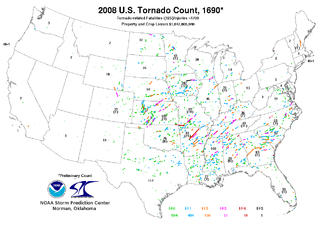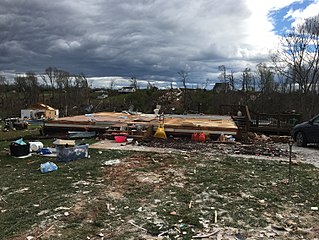
This page documents notable tornadoes and tornado outbreaks worldwide in 2008. Strong and destructive tornadoes form most frequently in the United States, Bangladesh, and Eastern India, but they can occur almost anywhere under the right conditions. Tornadoes also develop occasionally in southern Canada during the Northern Hemisphere's summer and somewhat regularly at other times of the year across Europe, Asia, and Australia. Tornadic events are often accompanied with other forms of severe weather, including strong thunderstorms, strong winds, and hail.

In 2009, tornadic activity was generally near average. Each year, tornadoes and tornado outbreaks occur worldwide primarily under conductive conditions, though a majority of tornadoes form in the United States. Tornadoes also occur to a less frequent extent in Europe, Asia, and Australia. In the U.S., there were 1,304 reports of tornadoes received by the Storm Prediction Center (SPC), and 1,159 tornadoes were confirmed to have taken place. Worldwide, 45 fatalities were caused by tornadoes, with 22 in the U.S., 15 in India, four in Canada, two in Greece and one each in Serbia and Russia.

The 2010 New Year's Eve tornado outbreak was a three-day-long tornado outbreak that impacted the central and lower Mississippi Valley from December 30, 2010 to January 1, 2011. Associated with a low pressure system and a strong cold front, 37 tornadoes tracked across five states over the length of the severe event, killing nine and injuring several others. Activity was centered in the states of Missouri and later Mississippi on December 31. Seven tornadoes were rated EF3 on the Enhanced Fujita Scale; these were the strongest during the outbreak. Non-tornadic winds were recorded to have reached as high as 80 mph (130 km/h) at eight locations on December 31, while hail as large as 2.75 in (7.0 cm) was documented north-northeast of Mansfield, Missouri. Overall, damage from the outbreak totaled US$123.3 million, most of which was related to tornadoes.

This page documents the tornadoes and tornado outbreaks of 2012. Extremely destructive tornadoes form most frequently in the U.S., Bangladesh, Brazil and Eastern India, but they can occur almost anywhere under the right conditions. Tornadoes also appear regularly in neighboring southern Canada during the Northern Hemisphere's summer season, and somewhat regularly in Europe, Asia, Argentina, and Australia.

On March 2 and 3, 2012, a deadly tornado outbreak occurred over a large section of the Southern United States into the Ohio Valley region. The storms resulted in 41 tornado-related fatalities, 22 of which occurred in Kentucky. Tornado-related deaths also occurred in Alabama, Indiana, and Ohio. The outbreak was the second deadliest in early March for the U.S. since official records began in 1950; only the 1966 Candlestick Park tornado had a higher death toll for a tornadic system in early March.

The 2011 Tuscaloosa–Birmingham tornado was a large and violent EF4 multiple-vortex tornado that devastated portions of Tuscaloosa and Birmingham, Alabama, as well as smaller communities and rural areas between the two cities, during the late afternoon and early evening of Wednesday, April 27, 2011. It is one of the costliest tornadoes on record. It was one of the 360 tornadoes in the 2011 Super Outbreak, the largest tornado outbreak in United States history. The tornado reached a maximum path width of 1.5 miles (2.4 km) during its track through Tuscaloosa, and once again when it crossed Interstate 65 north of Birmingham, and attained estimated winds of 190 mph (310 km/h) shortly after passing through the city. It then went on to impact parts of Birmingham as a high-end EF4 before dissipating. This was the third tornado to strike the city of Tuscaloosa in the past decade, and the second in two weeks.

This page documents the tornadoes and tornado outbreaks of 2013. Strong and destructive tornadoes form most frequently in the United States, Bangladesh, Brazil and Eastern India, but they can occur almost anywhere under the right conditions. Tornadoes also appear regularly in neighboring southern Canada during the Northern Hemisphere's summer season, and somewhat regularly in Europe, Asia, and Australia.

Near the end of 2012, a massive storm complex developed that produced both a tornado outbreak and a blizzard across the southern and eastern United States. On Christmas Day 2012, a tornado outbreak occurred across Southern United States. This severe weather/tornado event affected the United States Gulf Coast and southern East Coast over a two-day span. It occurred in conjunction with a much larger winter storm event that brought blizzard conditions to much of the interior United States. In total, 31 tornadoes were confirmed by the National Weather Service in five states from Texas to North Carolina. All but one of the tornadoes that occurred during the outbreak touched down on December 25, with the other occurring the following day in North Carolina. Two of the tornadoes were destructive enough to be rated EF3 on the Enhanced Fujita Scale. At least 16 people died as a result of the related blizzard, and thousands were without power.

The 2013 Hattiesburg, Mississippi tornado was a large and violent EF4 multiple-vortex wedge tornado that, on Sunday, February 10, 2013, devastated the city of Hattiesburg, Mississippi as well as portions of surrounding areas of West Hattiesburg, Hattiesburg, and Petal. The tornado was one of eight that touched down in southern Mississippi and southwestern Alabama that day. It reached a maximum path width of 0.75 mi (1.21 km) in its path through the Hattiesburg area and reached estimated maximum sustained winds of 170 mph (270 km/h) in Oak Grove neighborhood of West Hattiesburg. It destroyed many structures and impacted University of Southern Mississippi and two high schools. Mississippi was declared a federal disaster area by President Barack Obama, and a state of emergency was issued by Mississippi Governor Phil Bryant.

The tornado outbreak of November 17, 2013, was the deadliest and costliest in the U.S. state of Illinois to occur in the month of November and fourth largest for the state overall. Associated with a strong trough in the upper levels of the atmosphere, the event resulted in 73 tornadoes tracking across regions of the Midwest United States and Ohio River Valley, impacting seven states. Severe weather during the tornado outbreak caused over 100 injuries and eleven fatalities, of which eight were tornado related. Two tornadoes—both in Illinois and rated EF4 on the Enhanced Fujita Scale—were the strongest documented during the outbreak and combined for five deaths. In addition to tornadoes, the system associated with the outbreak produced sizeable hail peaking at 4.00 in (10.2 cm) in diameter in Bloomington, Illinois, as well as damaging winds estimated as strong as 100 mph (160 km/h) in three locations.

This page documents notable tornadoes and tornado outbreaks worldwide in 2015. Strong and destructive tornadoes form most frequently in the United States, Bangladesh, Brazil and Eastern India, but they can occur almost anywhere under the right conditions. Tornadoes also develop occasionally in southern Canada during the Northern Hemisphere's summer and somewhat regularly at other times of the year across Europe, Asia, and Australia. Tornadic events are often accompanied with other forms of severe weather including strong thunderstorms, winds and hail.

This page documents notable tornadoes and tornado outbreaks worldwide in 2016. Strong and destructive tornadoes form most frequently in the United States, Bangladesh, Brazil and Eastern India, but they can occur almost anywhere under the right conditions. Tornadoes also develop occasionally in southern Canada during the Northern Hemisphere's summer and somewhat regularly at other times of the year across Europe, Asia, and Australia. Tornadic events are often accompanied with other forms of severe weather, including strong thunderstorms, strong winds, and hail.

This page documents notable tornadoes and tornado outbreaks worldwide in 2017. Strong and destructive tornadoes form most frequently in the United States, Brazil, Bangladesh, and Eastern India, but they can occur almost anywhere under the right conditions. Tornadoes also develop occasionally in southern Canada during the Northern Hemisphere's summer and somewhat regularly at other times of the year across Europe, Asia,Argentina and Australia. Tornadic events are often accompanied with other forms of severe weather, including strong thunderstorms, strong winds, and hail.

The tornado outbreak of January 21–23, 2017 was a prolific and deadly winter tornado outbreak that occurred across the Southeast United States. Lasting just under two days, the outbreak produced a total of 81 tornadoes, cementing its status as the second-largest January tornado outbreak and the third-largest winter tornado outbreak since 1950. Furthermore, it was the largest outbreak on record in Georgia with 42 tornadoes confirmed in the state. The most significant tornadoes were three EF3s that heavily damaged or destroyed portions of Hattiesburg, Mississippi, and Albany and Adel, Georgia. A total of 20 people were killed by tornadoes—mainly during the pre-dawn hours of the outbreak—making it the second-deadliest outbreak in January since 1950, behind the 1969 Hazlehurst, Mississippi tornado outbreak that killed 32 people. In the aftermath of the outbreak, relief organizations assisted in clean-up and aid distribution. Total economic losses from the event reached at least $1.3 billion.

The 2015 Rochelle–Fairdale, Illinois tornado was an extremely violent and long-lived tornado that tore through the communities near Rochelle and in Fairdale, Illinois throughout the evening hours of April 9, 2015. Part of a larger severe weather event that impacted the Central United States, the tornado first touched down in Lee County at 6:39 p.m. CDT (22:39 UTC). It progressed through the counties of Ogle, DeKalb, and Boone before finally dissipating at 7:20 p.m. CDT. Along the tornado's 30.14 mi (48.51 km) path, numerous structures were heavily damaged or destroyed, especially in the small town of Fairdale where two fatalities and eleven injuries were recorded. A few well-constructed homes were swept completely away, indicative of peak winds near 200 mph (320 km/h), the upper bounds of an EF4 tornado. In the aftermath of the event, hundreds of citizens assisted in cleanup and recovery efforts. Economic losses from the tornado reached $19 million.

The tornado outbreak of February 28 – March 1, 2017 was a widespread and significant outbreak of tornadoes and severe weather that affected the Midwestern United States at the end of February 2017 and beginning of March. Fueled by the combination of ample instability, strong wind shear, and rich low-level moisture, the event led to 72 confirmed tornadoes and thousands of other non-tornadic severe weather reports. The most notable aspect of the outbreak was a long-tracked EF4 tornado—the first violent tornado of 2017 and the first violent tornado during the month of February since the 2013 Hattiesburg, Mississippi tornado—that tracked from Perryville, Missouri to near Christopher, Illinois, killing one person. Three EF3 tornadoes were recorded during the event, including one that caused two fatalities in Ottawa, Illinois, one that caused a fatality near Crossville, and one that heavily damaged or destroyed homes in and around Washburn. In addition to the deaths, 38 people were injured by tornadoes and an additional 30 were injured by non-tornadic impacts, mainly by fallen trees.

The tornado outbreak of April 13–15, 2018 was a multi-day and significant tornado outbreak that affected portions of the Midwest across to the East Coast of the United States. This particular outbreak led to at least 73 confirmed tornadoes over a three-day period, most of which occurred across Arkansas and Louisiana during the evening hours of April 13. The most significant tornadoes were an EF1 that caused a fatality in Red Chute, Louisiana, early on April 14, an upper-end EF2 tornado that impacted eastern sections of Greensboro, North Carolina on April 15, causing 17 injuries, and a significant EF3 tornado that impacted areas from Lynchburg to Elon, Virginia, causing severe damage and at least 10 injuries. The larger extratropical cyclone responsible for the outbreak also resulted in a record-breaking and severe winter storm across the Midwest into the Northeastern United States; killing three additional people and leaving hundreds of thousands without power.

This page documents notable tornadoes and tornado outbreaks worldwide in 2019. Strong and destructive tornadoes form most frequently in the United States, Argentina, Brazil, Bangladesh, and Eastern India, but can occur almost anywhere under the right conditions. Tornadoes also develop occasionally in southern Canada during the Northern Hemisphere's summer and somewhat regularly at other times of the year across Europe, Asia, Argentina, and Australia. Tornadic events are often accompanied by other forms of severe weather, including strong thunderstorms, strong winds, and hail.

The tornado outbreak of March 3, 2019 was a significant severe weather event that affected the Southeastern United States. Over the course of 6 hours, a total of 41 tornadoes touched down across portions of Alabama, Georgia, Florida, and South Carolina. The strongest of these was an EF4 tornado that devastated rural communities from Beauregard, Alabama to Talbotton, Georgia, killing 23 people and injuring at least 100 others. Its death toll represented more than twice the number of tornado deaths in the United States in 2018, and it was the deadliest single tornado in the country since the 2013 Moore EF5 tornado. An EF3 tornado destroyed residences to the east of Tallahassee in Leon County, Florida, and was only the second tornado of that strength in the county since 1945. Several other strong tornadoes occurred across the region throughout the evening of March 3 and caused significant damage. A large number of EF0 and EF1 tornadoes also touched down.

The tornado outbreak of April 13–15, 2019, was a significant severe weather event that affected the multiple regions of the Eastern United States. Over the course of 40 hours, 70 tornadoes touched down. The outbreak produced numerous strong tornadoes throughout portions of the Deep South, while additional significant tornadoes occurred as far north as Ohio, Pennsylvania, and Delaware. The most significant tornado of the event was a long-tracked, high-end EF3 tornado that struck Alto, Texas and killed two people. Numerous weak tornadoes were also confirmed, along with numerous reports of hail and damaging straight line winds. Damage surveys are still ongoing.


































